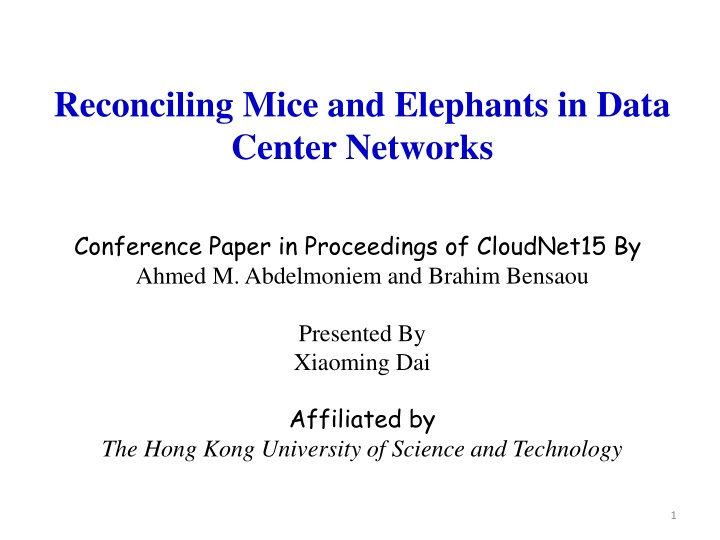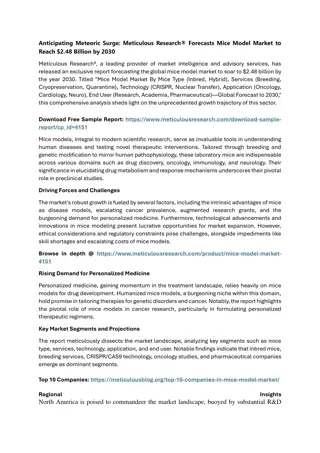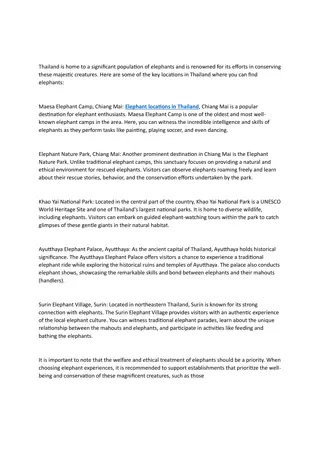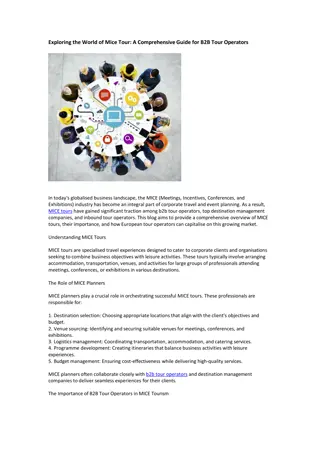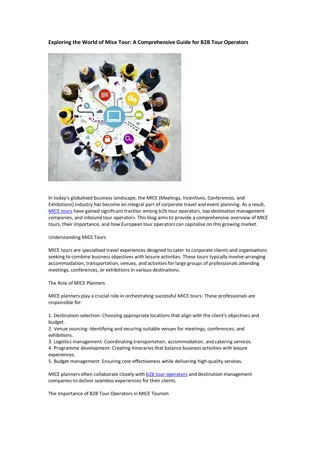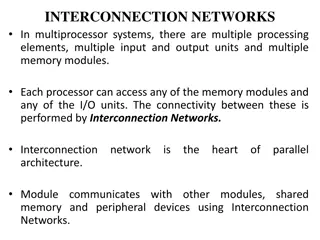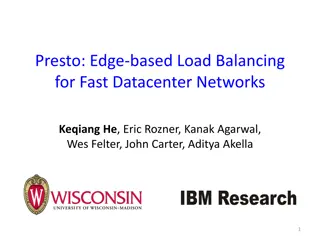Reconciling Mice and Elephants in Data Center Networks
This conference paper discusses the challenges and strategies of managing different types of workloads in data center networks, focusing on mice (small, delay-sensitive messages) and elephants (large, throughput-sensitive flows). The conflict between these workloads is explored, along with potential solutions such as TCP variants and congestion control mechanisms.
Download Presentation

Please find below an Image/Link to download the presentation.
The content on the website is provided AS IS for your information and personal use only. It may not be sold, licensed, or shared on other websites without obtaining consent from the author.If you encounter any issues during the download, it is possible that the publisher has removed the file from their server.
You are allowed to download the files provided on this website for personal or commercial use, subject to the condition that they are used lawfully. All files are the property of their respective owners.
The content on the website is provided AS IS for your information and personal use only. It may not be sold, licensed, or shared on other websites without obtaining consent from the author.
E N D
Presentation Transcript
Reconciling Mice and Elephants in Data Center Networks Conference Paper in Proceedings of CloudNet15 By Ahmed M. Abdelmoniem and Brahim Bensaou High Performance Switching and Routing Telecom Center Workshop: Sept 4, 1997. Presented By Xiaoming Dai Affiliated by The Hong Kong University of Science and Technology 1
Partition/Aggregate Application Structure Time is money Strict deadlines (SLAs) Missed deadline Lower quality result The foundation for many large-scale web applications. Web search, Social network, Ad selection. Examples : Google/Bing Search, Facebook Queries 2
Typical Workloads - Mice Partition/Aggregate Delay-sensitive (Query) Short messages [50KB-1MB] Delay-sensitive (Coordination, Control state) Majority in data centers (Contributes small number of bytes) Mice 3
Typical Workloads - Elephant Large flows [>1MB] Throughput-sensitive (Data update, VM migration) Minority in data centers (Contribute large number of bytes) Elephant 4
The Conflict Partition/Aggregate Delay-sensitive (Query) Short messages [50KB-1MB] Delay-sensitive (Coordination, Control state) Large flows [>1MB] Throughput-sensitive (Data update, VM migration) 5
TCP in the Data Center TCP and its variants do not meet demands of applications in DC environment. Suffers from bursty packet drops, Incast Problem Elephants build up large queues: Adds significant latency. Wastes precious buffers, esp. bad with shallow-buffered switches. Goal: Design an appropriate congestion control for data centers. Window-based Solutions: DCTCP [1], ICTCP [2] Loss Recovery Schemes: Reducing MinRTO [3], Cutting- Payload [4]. 6
Drawbacks of proposed solutions Data centers (esp. public ones) allows provisioning of VMs from different OS images each running a different TCP flavor Fairness and stability issues. 7
Drawbacks of proposed solutions (Cont.) Requires modifications of TCP stack at the sender or the receiver or both Not feasible if one of the peers are outside the data center. 8
Data Center Transport Requirements 1. High Burst Tolerance. 2. Low Latency for mice and High Throughput for elephants. 3. fit with all TCP flavors. 4. No modifications to the TCP stack at all. The challenge is to achieve these Conflicting Requirements. 9
TCP Flow Control is the answer Flow Control is part of all TCP flavors Data Data Receiver Sender ACK ACK TCP header has a Receive Window Field to convey amount of buffer left at the receiver. Send Window = Min (Congestion Win, Receive Win). 10
Two Key Ideas 1. Switch s egress port toward destination is a receiver of the data. Buffer occupancy change over time Buffer occupancy reflects level of congestion. Locality of number of ongoing flow information. 2. Send explicit feedback by leveraging TCP receive window. Similar to XCP and ATM-ABR techniques. Receive window controls the sending rate. Feedback is less than RTT away. Fast reaction to congestion events. Low computation and rewriting overhead. 11
RWNDQ Algorithm Switch side (Local window proportional to queue occupancy): Increase receive window when below the target. Decrease when we are above the queue target. Slow start to initially reach target fast. Switch Port Queue Target Data Data ACK ACK Sender/Reciever side (No Change): Send Window = Min(Congestion Win, Receive Win) 12
RWNDQ Convergence Using fluid approach to model how RWNDQ reacts proportionally Expectation: average queue converges to target as t goes to infinity Experiment: run model in Matlab where target is set to 16.6 pkts 13
RWNDQ Fairness Using implementation of RWNDQ in NS2. Expectation: Better fairness and small variance due to equal buffer allocation among competing flows and shorter control loop. Experiment: run 5 flows successively and compare with DCTCP DCTCP RWNDQ 14
Performance Analysis - MICE NS2 simulation and compare with XCP, DCTCP. Scenarios depicting Mice colliding with Elephants. Mice Goal: Low Latency and low variability *CDF: shows distribution over mice flows only 15
Performance Analysis - Elephants NS2 simulation and compare with XCP, DCTCP. Scenario depicting Mice colliding with Elephants. Elephants Goal: High throughput *CDF: shows distribution over elephant flows only 16
Performance Analysis - Queue NS2 simulation and compare with XCP, DCTCP. Scenario depicting Mice colliding with Elephants. Queue Goal: Stable and small persistent queue 17
Performance Analysis - Link NS2 simulation and compare with XCP, DCTCP. Scenario depicting Mice colliding with Elephants. Link Goal: High Link Utilization over the time *Drop in utilization for RWNDQ is only at the beginning of incast epoch due to its fast reaction and redistribution of bandwidth 18
Why RWNDQ Works 1.High Burst Tolerance Large buffer headroom bursts fit. Short control loop sources react before packets are dropped. 2. Low Latency Small queue occupancies low queuing delay. 3. High Throughput Fair and fast bandwidth allocation mice finish fast and elephants retrieve back the bandwidth fast. 19
Conclusions RWNDQ satisfies all mentioned requirements for Data Center packet transport. Handles bursts well. Keeps queuing delays low. Achieves high throughput. Fits with any TCP flavor running on any OS. No Modifications to TCP stack. Features: Very simple change to switch queue management logic. Allows immediate and incremental deployment. 20
References [1] M. Alizadeh, A. Greenberg, D. A. Maltz, J. Padhye, P. Patel, B. Prabhakar, S. Sengupta, and M. Sridharan, Data center TCP (DCTCP), ACM SIGCOMM Computer Communication Review, vol. 40, p. 63, 2010. [2] H. Wu, Z. Feng, C. Guo, and Y. Zhang, ICTCP: Incast congestion control for TCP in data-center networks, IEEE/ACM Transactions on Networking, vol. 21, pp. 345 358, 2013. [3] V. Vasudevan, A. Phanishayee, H. Shah, E. Krevat, D. G. Andersen, G. R. Ganger, G. A. Gibson, and B. Mueller, Safe and effective fine-grained TCP retransmissions for datacenter communication, ACM SIGCOMM Computer Communication Review, vol. 39, p. 303, 2009. [4] P. Cheng, F. Ren, R. Shu, and C. Lin, Catch the Whole Lot in an Action: Rapid Precise Packet Loss Notification in Data Center, in Proceedings of the 11th USENIX Symposium on Networked Systems Design and Implementation (NSDI 14), pp. 17 28, 2014. 21
